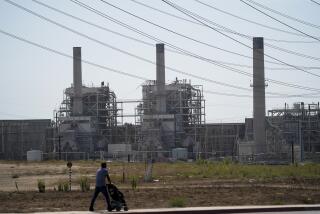China faces summer energy shortage
Reporting from Beijing — Chinese electricity plants are cutting output in the face of soaring coal prices, setting up what could be the worst summer energy crunch in years and threatening to slow the nation’s manufacturing sector.
State Grid Corp., China’s biggest power distributor, has warned that shortages this year could exceed those of 2004, when dry weather cut hydroelectric production, prompting rolling blackouts through much of the country.
The current crisis is linked to coal, which fuels most of the nation’s electricity plants. Coal prices have exploded. But the government, nervous over rising inflation, has prevented power producers from passing those higher fuel costs on to businesses and consumers.
The nation’s top five power producers lost $1.6 billion in their thermal power plants during the first four months of the year, according to the China Electricity Council. In response, they’re cutting output.
“If the coal power plants want to generate more power, they can, but the incentives aren’t there,” said Lin Boqiang, director of the China Center for Energy Economics Research at Xiamen University. “When you’re losing money, you’re not interested in generating more power.”
Some regions of the country are already feeling the pinch. In the manufacturing hub of Zhejiang province in eastern China, some businesses have been forced to halt production for 24 hours every three days, according to China Daily.
Industries such as steel, iron and cement production account for the bulk of China’s energy use. Large steel factories usually have stand-alone power plants, so tightening supplies are likely to affect small and midsize businesses.
Droughts in southern China’s Yangtze River basin have led to diminished power output at the Three Gorges Dam.
The world’s largest hydroelectric power plant has had to release water to aid farmers in the region irrigating their land. This has caused the water level at the reservoir to sink to 502 feet, about 10 feet below the optimum level for energy production.
But officials overseeing drought relief have said that the fields are still parched and are pushing for more water to be released, which would further affect the dam’s power production ability.
More to Read
Inside the business of entertainment
The Wide Shot brings you news, analysis and insights on everything from streaming wars to production — and what it all means for the future.
You may occasionally receive promotional content from the Los Angeles Times.










